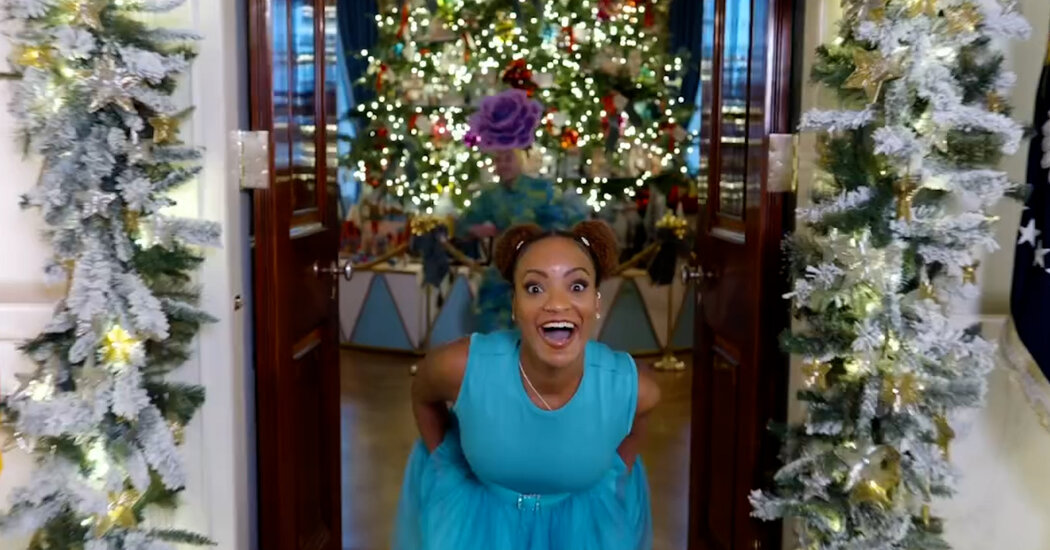It’s December and the White House is alive with the sound of music — and the joyful sound of tapping feet. What could be more festive, more wholesome?
In a short video posted to Instagram by Jill Biden, a group of dancers perform a tap version of “The Nutcracker.” Shot at the White House for the holiday season, it’s an excerpt from “The Nutcracker Suite,” a production by the award-winning Dorrance Dance, led by Michelle Dorrance.
The clip drew heavy criticism on Fox News and in The New York Post. It was shocking to see something as innocuous as “The Nutcracker” stir up such outrage.
In an interview on Friday, Ms. Dorrance said, “I think my values are about uplifting and protecting human life.”
The White House video opens on Josette Wiggan, wearing a sequined romper with spheres jutting from the sides of her waist — a fantasy tutu befitting the story’s Land of the Sweets — as she turns with open arms. She is Sugar Rum Cherry. Think of the Sugar Plum Fairy, only cooler.
Gliding backward, she heads down a hallway flanked by giant candy canes as her shoulders send a ripple down her long arms and her fingers snap to the tune of the “Dance of the Floreadores,” set to Duke Ellington and Billy Strayhorn’s 1960 jazz arrangement of Tchaikovsky’s “Nutcracker.”
The film is an invitation to a dance — and not just to any “Nutcracker,” but to one that celebrates two points of American cultural pride: tap dance and jazz. Both are marginalized art forms, which makes transmitting the video from the White House all the more significant. And it’s also enchanting. Dr. Biden, correctly, calls it playful in her post, writing: “A bit of magic, wonder, and joy brought to you by the talented tappers of Dorrance Dance.”
In many ways, the “Dance of the Floreadores” feels like a throwback to vintage Hollywood. (The production is choreographed by Ms. Dorrance, Hannah Heller and Ms. Wiggan.) The performers, dressed as characters from the work — including a Cavalier, a Flower with a giant purple headpiece, a Rat King — light up the score with sweeping, frisky steps as they spin from room to room in solo turns and end as a group, Ms. Wiggan in front as she blows a kiss in a final flourish.
But this offering of dance joy has drawn criticism from those who see it as dystopian. It’s hard to imagine that this is news to anyone, but “The Nutcracker” is a fantasy. It can get weird, and even a little dark. In the choreographer George Balanchine’s classic 1954 version, performed by New York City Ballet this month at Lincoln Center, a Nutcracker Prince goes to battle with the Mouse King, ultimately stabbing him to death. (This inevitably leads to loud applause.) The characters in all versions of “The Nutcracker” are over the top — that’s the point.
The White House video also drew criticism directed more personally at Ms. Dorrance, the artistic director of the company, which was formed in 2011. Ms. Dorrance is a 2015 MacArthur Fellow, and deservedly so. In the video, she dances with an oversize candy cane, as her trademark hoop earrings sway in the breeze propelled by her flying feet.
Ms. Dorrance is also a white woman in a traditionally Black form, as well as an artist who deeply respects her tap ancestors. In a statement on her website, she writes, “In my generation, to be a tap dancer is to be an ambassador to the world for the unsung history of a Black art form.”
And for her it’s important to acknowledge why she is in the position she is in. “My whiteness is the reason you may have heard of me before two of my inspirations, Ayodele Casel and Dormeshia,” she writes, “not to mention the legendary inspiration, elder, and griot, Dianne Walker.”
The holiday tour also took the company to the Kennedy Center in Washington, which led to the White House video, shot in less than an hour in the East Wing, Ms. Dorrance said. In touring “The Nutcracker Suite,” she added, the group recognizes “that this is a time of tremendous pain and heartache in the world. And what we do is empower young people to become forces of good, and this story is not a story that generally represents most kids in this country.”
Ms. Wiggan said: “When you watch a traditional ‘Nutcracker,’ a lot of kids in marginalized groups don’t necessarily see themselves in the stories. They might not necessarily connect. So what we tried to create was a version of this story that was inclusive.”
“Being able to perform it in a platform like this,” she added, “we were excited at the idea of being able to share this with many people that probably have never seen tap dance.”


